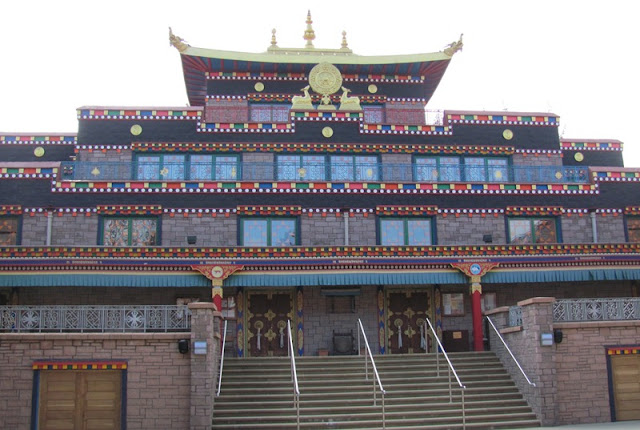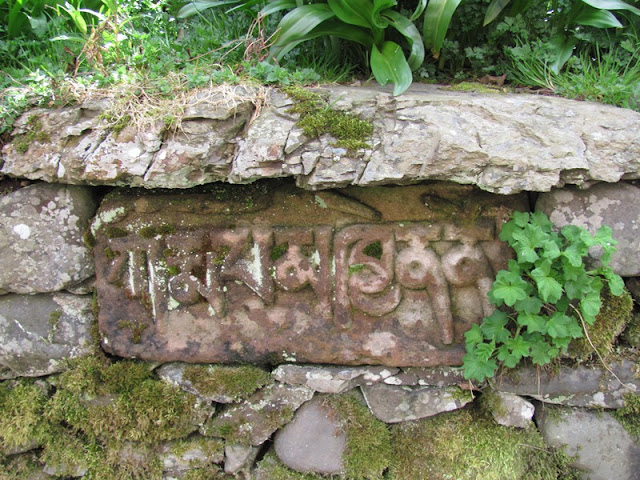There has been a Buddhist centre it Eskdalemuir since 1965 but it was in 1967 that two exiled Tibetan Buddhist monks were invited to take over and gave the monastery the identity it has today. Despite a certain amount of controversy, the Kagyu Samye Ling monastery and Tibetan centre appears to have gone from strength to strength in the intervening years and there was still a fair amount of building work going on when I was there for a visit last week. http://www.samyeling.org/. The name is taken from the Samye monastery in Tibet and ling means place.
A view of the monastery as I approached from the car park.

In the middle of a pond is a statue of Nagarjura who was a Mahayana Buddhist master from the 1st century AD in India. He travelled to the land of the Nagas, or water spirits. The cobra rising up behind him in this statue is the king of the Nagas and is shielding him from the sun and rain.
This is the Victory Stuppa. A Stuppa is a structure which contains Buddhist relics or as commemoration of something. This one is dedicated to honouring people who have died and is used in the monastery's funeral ceremonies.
I'm not sure if there are ashes contained within the stupa itself, I didn't go in, I'm not sure if you can, but there are certainly some contained withing the cupboards of the Prayer Wheel House. The prayer wheels contain millions of mantras, or prayers, written on paper, soaked in saffron water and blessed. As the wheels are turned clockwise the mantras are activated. Traditionally turned by hand as you walk through, and here the first few can be, but I noticed that technology has caught up with them and the rest had little motors on them and turned constantly on their own.

The eight stupas line the entrance to the Samye Ling. When the Buddha died his ashes were put into eight Stupas, each representing an important event in his life. If my arithmetic is still sound after all these years, there are quite a few more than eight here so perhaps some are for another reason.
There is a small gold Buddha in each.
This stained glass window is situated outside the courtyard leading into the courtyard outside the temple.
Finished in 1988 impressive Tibetan temple is the spiritual centre of the monastery.
The main shrine room is richly painted in gold and red, with two large gongs and numerous cushions for sitting. As well as the large Buddha in the centre, there are a thousand small golden Buddhas in glass cases around the wall. A sign post asks that pictures shouldn't be taken without permission, so I have snaffled this one from the Guardian's website (it looks like a bigger version of the one the Samye Ling's website)
A rather gloriously painted door round the back of the temple.
A couple of close ups of the paintwork.
A stone in a wall is carved with a mantra.
Here's another in granite with the characters painted.
The Cloutie tree invites people to make a wish and and tie a cloth to tree in the hope that as the cloth wears away the wish may come true (considerably neater than the Clootie well in the Black Isle featured near the bottom of this blog)

The Tara garden wasn't really accessible due to building work but the statue of Tara was quite big enough to be taken from a distance.
This peacock looked quite content to be sitting on top of a pile of building materials.
On the way out I passed through the Samye Liberation Gate, similar in design to the gates on Tibetan temples. The Dharma wheel and two deer on the roof represent the Buddha's teachings and around the gate are various scripts and symbols which are relevant to Buddhism.
At the bottom of the pillars are painted the Four Great Kings who are guardians of the four directions and ward of negative forces. Here are two.
As I was walking back to the car, I spotted this sign on a gate across the road.
There's the hill and looks like some prayer flags on top of it.
By the time I got to the top, there were quite a lot of prayer flags
There were a number of little altars where people had left offerings.

























7 comments:
Lots to please the eye there, pleased the allow photos so that you could share it with us!
Thanks Pam and Wayne - there's one or two places there I didn't see - sometimes yoou weren't allowed and a few corners I just plain missed.
Well I seem to have missed a whole slew of posts this past week, and how could I not comment on this one? Tibetan places are much more colourful than zen temples, as you probably gathered, and I enjoyed the incongruity of all that architecture and statuary in a Scottish landscape. Hope you had an inspiring visit - and did you get a cup of tea off them?
Shundo, there is a definate air of built to impress about the Eskdalemuir temple (judging by the pictures of the SFZC they're definately beating you on gilding things. You may have to wear sunglasses while outside but not during your ceremonies - it may be the opposite way round at the Samye Ling). It's still very peaceful though.
I had a cup of tea in their wee cafe as well as a samosa and cheese and onion pasty - very cheap indeed.
As I suspected - glad to hear it
I remember a workmate a few years ago going on a retreat to a Buddhist monastery. After a few more years of study I believe he became a monk. Did you come across any monks with a Lincolnshire accent ?
No sign of Lincolnshire monks I'm afraid Jim - mind you, I didn't talk to that many.
Post a Comment